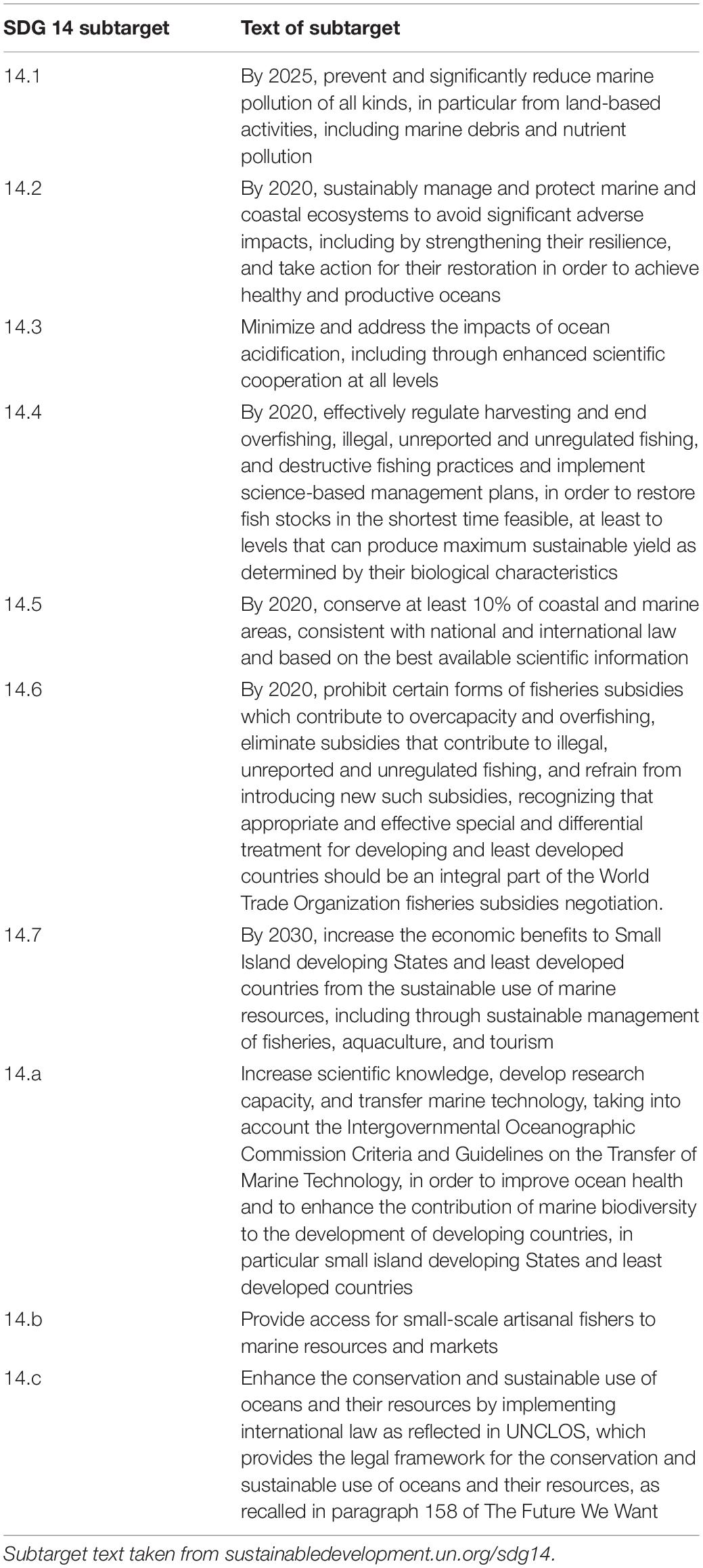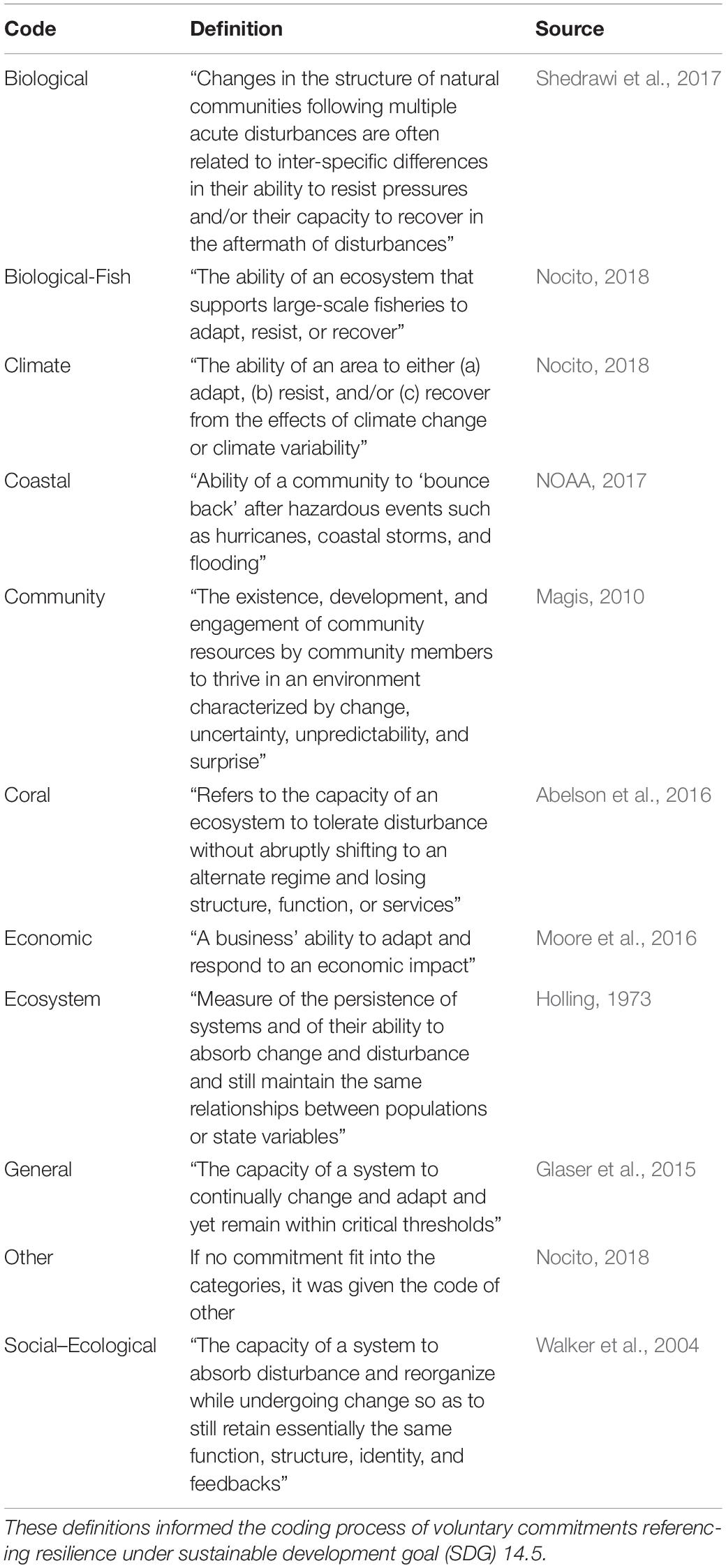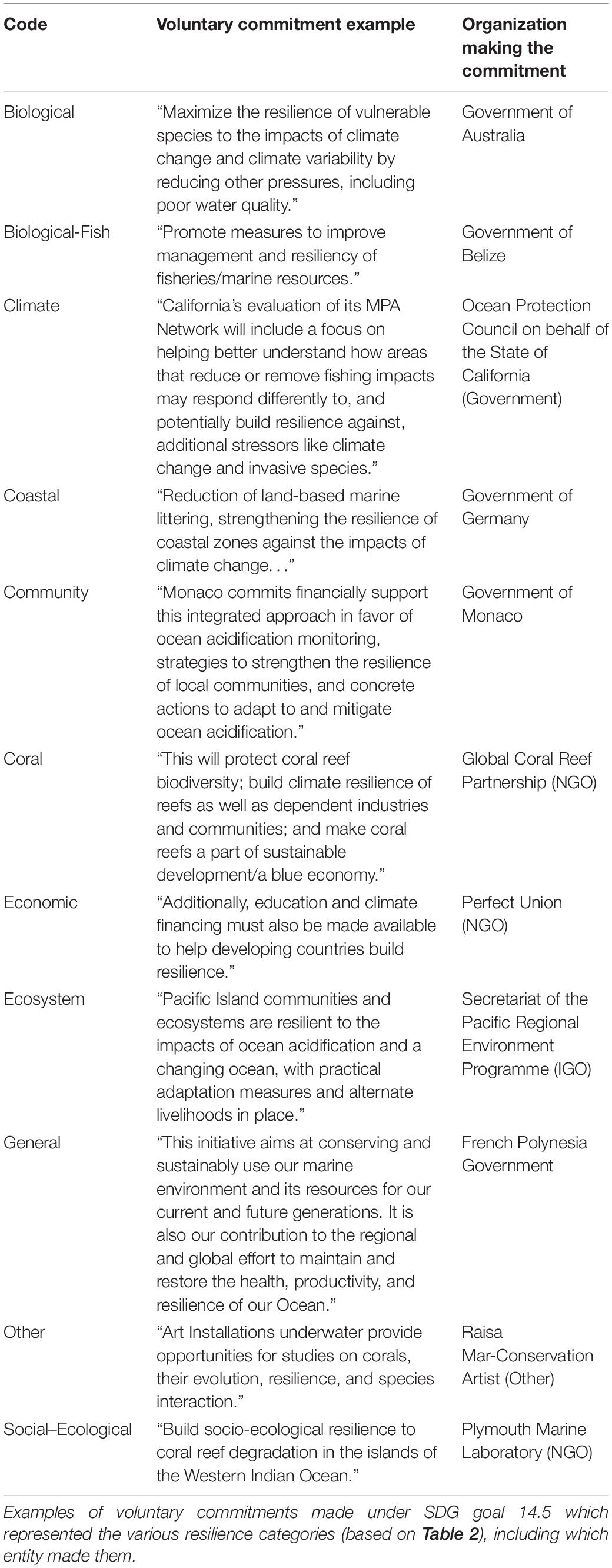- 1Environmental Studies Program, University of Colorado Boulder, Boulder, CO, United States
- 2School of Marine Sciences, The University of Maine, Orono, ME, United States
- 3Environmental Studies Program, Hamilton College, Clinton, NY, United States
The beginning of 2015 saw a new era within the United Nations: the era of the sustainable development goals (SDGs). Built off the previous Millennium Development Goals, this new set of goals included 17 target areas, including, for the first time, an explicit global goal related to the ocean. In June 2017, at the United Nations Headquarters in New York City, a high-level conference surrounding SDG 14: Life Under Water convened. One dimension of goal 14 calls for 10% of the ocean conserved by the year 2020, through sub-target 14.5. That 10% fulfillment is often thought of in terms of areal coverage via marine protected areas (MPAs). While many objectives were laid out for this conference, one of the most prominent objectives was to build on existing partnerships and foster new collaborations. One way to achieve this target was through the creation of the voluntary commitment program. This “Call for Action” came from heads of state and government, as well as high-level representatives from organizations and stakeholder groups. Under this “Call for Action,” 22 actions related to goal 14 were listed for stakeholders to partake in, including an appeal to create voluntary commitments surrounding the oceans. As of September 2017, 1,395 voluntary commitments had been registered through the voluntary commitment portal process, spanning across organizations and disciplines. Here, we analyze these commitments, specifically those related to the fifth sub-target of SDG 14. Commitments were further refined through spotlighting on those under 14.5 that focused on different forms of resilience. The resulting 133 separate codes covered over 12 distinct forms of resilience. Through analyzing commitments, we map out future plans and predict different forms of MPAs. This research shows collaboration and co-production of knowledge linking across the SDGs. This work can be seen as a stepping-stone to the fulfillment of 10% conservation by 2020.
Introduction
Marine protected areas (MPAs) are regions of the ocean where specific human activities are limited or prohibited, and have been increasingly promoted by policy-makers, scientists, and conservationists as a tool for mitigating ocean threats, conserving biodiversity, managing fisheries, and enhancing resilience to climate change (Lester et al., 2009; Gaines et al., 2010; Lubchenco and Grorud-Colvert, 2015; Roberts et al., 2017). In recent years, the global spatial extent of MPAs has increased across the world’s oceans, with 4.8% of the world’s ocean area currently under some form of protection in 2018 (MPAtlas.org, 2018).
The political calls for increased use of MPAs arise from numerous studies that demonstrate that MPAs – especially no-take MPAs (also known as marine reserves) – provide significant positive ecosystem benefits (Baskett and Barnett, 2015). These benefits include increases in biomass, density, size, and diversity of life in the region (Lester et al., 2009; Caselle et al., 2015). Benefits derived from MPAs also include benefits to fisheries, including by facilitating the recovery of depleted fisheries and by providing spillover effects (Gaines et al., 2010; Halpern et al., 2010). Further, because they maintain all trophic levels of the ecosystem and increase both species and genetic diversity, MPAs can enhance resilience to ecosystem changes, including those brought about by climate change (Olds et al., 2014; Roberts et al., 2017).
Despite an increasing trend toward implementing MPAs, doing so in international waters has proved to be a more difficult challenge. It was only recently that MPAs were created within what are commonly called “areas beyond national jurisdiction” (ABNJs) (Gjerde et al., 2008; Wells et al., 2016; Smith and Jabour, 2018). To date, only 1.2% of the high seas fall under protection1, which comprises only 12 total MPAs within ABNJs governed by two different regional management bodies (Ardron et al., 2008; De Santo, 2018). Ten of these MPAs are under the management of the OSPAR Convention and the North East Atlantic Fisheries Commission. The remaining two are located in Antarctica and are managed under the Convention for the Conservation of Antarctic Marine Living Resources. Yet, ABNJs account for >60% of the global ocean by area and include critically important areas for biodiversity and ecosystem processes (Rogers et al., 2014; Gjerde et al., 2016).
The path to creating MPAs in ABNJs may become clearer. After 10 years of discussion, the United Nations General Assembly is adopting a resolution related to the sustainable use and conservation of the marine environment within ABNJs. This resolution will create an international legally binding instrument providing for the adoption of MPAs, as well as other key concerns such as marine genetic resources and environmental impact assessments (United Nations, 2017b). This process of United Nations meetings to create the legally binding instrument is set to end in 2020, although when the instrument will come into effect is still unknown.
Due to increasing loss of, and continued threats to marine biodiversity (McCauley et al., 2015) MPAs have become a focal point within international agreements and conferences in the last 10 years. This includes: the first International MPA Conference in 2005 and the adoption of the Convention on Biological Diversity (CBD) in 1992 (National Research Council, 2001). A number of international targets have been promulgated regarding the adoption of MPAs in national waters and in ABNJ. At the 2002 World Summit on Sustainable Development, participating States agreed to designate a global network of MPAs by 2012 encompassing 10% of all ecological regions (Gjerde et al., 2016). This call was further reiterated at both the 2003 and 2008 International Union for Conservation of Nature (IUCN) World Conservation Congresses, which called for protected areas to encompass 20–30% of all marine habitats (Gjerde et al., 2016). The 2010 Aichi Biodiversity Targets adopted by the Convention on Biological Diversity offered a new deadline of 2020 to designate 10% of the global ocean as protected areas. Finally, in 2014 the IUCN World Parks Congress recommended that 30% of the ocean be protected through the designation of MPAs. Given that <5% of the global ocean falls within MPAs, countries still have a long way to go to reach global targets and doing so in ABNJs will be a key element. Despite the challenges of creating MPAs in ABNJ, the increased development of MPAs globally has been accompanied by an interest in the role that MPAs can play in making marine systems more resilient to climate change impacts (Roberts et al., 2017). The increasing use of the climate resilience rationale for MPA creation (as opposed to a more traditional focus on biodiversity conservation) changes stakeholder perceptions of MPAs as policy instruments (Hopkins et al., 2016). Here, as we assess the future of MPAs in the new global ocean regime, the rise of the resilience rationale merits attention.
Sustainable Development Goal 14.5
In 2015, the United Nations agreed to 17 sustainable development goals (SDGs) to replace the previously held Millennium Development Goals. Under these 17 SDGs, goal 14 is often referred to as the Ocean goal, as its primary goal is “to conserve and sustainably use the oceans, seas and marine resources for sustainable development” (United Nations, 2017a). Goal 14 includes 10 subtargets relating to all things marine, such as ocean acidification and illegal, unregulated and unreported fishing (Table 1). With regards to MPAs, specifically, SDG 14.5 calls for that “[b]y 2020, [to] conserve at least 10 per cent of coastal and marine areas, consistent with national and international law and based on the best available scientific information.” (United Nations, 2018). SDG 14.5 is measured in terms of success, which calls for “[c]overage of protected areas in relation to marine areas” (United Nations, 2018).
Sustainable development goal 14 is in its moment of prominence. In June 2017, a week-long, high-level United Nations conference met at the UN Headquarters in New York City to discuss the world’s ocean, and specifically to advance the implementation of SDG 14. This meeting, called the United Nations Ocean Conference, was the first UN conference dedicated explicitly to discussing issues surrounding the marine environment. In addition to country delegations, participants included non-governmental organizations (NGOs), UN entities, academic institutions, civil-society organizations, inter-governmental organizations (IGOs), partnerships, as well as members of the private sector. Days were made up of partnership dialogs that focused on different ocean themes, as well as side events hosted by different state and non-state actors.
One stated objective of the conference was to build on existing partnerships and foster new collaborations that focused on ocean issues, including conservation and MPAs (United Nations, 2016). One proposed way to achieve this objective was through the creation of a voluntary commitment program for fulling SDG 14, including all of its 10 subtargets. This “Call for Action” was produced during a February preparatory meeting preceding the Ocean Conference, and came from the heads of state and government, as well as high-level representatives.
Under this Call for Action, developed by nation-state delegations, 22 endeavors were listed for stakeholders to partake in. Among these endeavors was an appeal to create a voluntary commitments database regarding oceans. This database was proposed to be open to anyone, including governments, NGOs, and even individuals. The Call for Action was also published on the official website of the UN Ocean Conference, allowing it to be viewed by those attending the meeting as well as the wider public. During the months preceding the 2017 United Nations Ocean Conference, as well as after, stakeholders were invited to make voluntary commitments under SDG 14. As of September 2017, 1,395 commitments were registered through the voluntary commitment process, spanning across organizations and areas of focus related to SDG 14 as a whole. To date, the voluntary commitment call is still open and accessible, and the website features updates on previously made commitments.
One way to understand where the world is headed in terms of global MPA targets is through dissecting the voluntary commitment process under the 2017 UN Ocean Conference. Here, we analyze a subset of these commitments that are specifically related to SDG 14.5, which focuses on the creation of MPAs. Analyzing the distribution of voluntary commitments surrounding MPAs offers a potential predictor of whether the goal of 10% protection of the oceans will be achieved. Using government commitments under 14.5, we created a map of potential MPA commitments, including those focused on resilient MPAs. An emergent theme from the data was that many of the MPA commitments referenced resilience, but did not define what form of resilience was to be achieved. Resilience can be thought of as a cluster concept, in that it is a word with multiple meanings (Parsons, 1973). Resilience as a benefit of MPAs has been written on extensively, but often lacks an operational definition (Nocito, 2018). Below we present on the overall number of voluntary commitments made, which actors made them, the geographic location of the commitment, and the kind of MPA committed. We then further present on the use of resilience in the voluntary commitments, including which actors focused on resilience and the forms of resilience referred to. Finally, we reflect on the potential strengths and weaknesses of these voluntary commitments in moving forward toward a global system of MPAs.
Materials and Methods
To study the voluntary commitment process of the UN Ocean Conference, we completed an empirical textual analysis of the content of the voluntary commitments. To create a voluntary commitment, a member of an organization must fill out a commitment registration form online. Some of the information is open-ended, such as project timeline, partners, and description. Other aspects are preset, such as what aspects of SDG 14 does the commitment concern and what features of an MPA are being committed to. The preset feature, however, also prevented capture of some finer details, such as size of MPA being proposed.
To carry out our textual analysis, we downloaded voluntary commitments2 related to SDG 14 in September 2017, 3 months after the close of the UN Ocean Conference. This database is publicly accessible. To identify how priorities were distributed over the entirety of SDG 14, we sorted all the commitments by what sub-goals of SDG were selected as being achieved through the commitment. To gain a better understanding of what entities were creating commitments of SDG 14 overall, we then sorted commitments by the nature of the actor making the commitment. Actors include: Government, UN entities, IGOs, NGOs, civil society organizations (CSOs), Academic Institutions, Scientific Communities, Private Sector, Philanthropic Organizations, Partnerships, and Others. This pre-sorting gave us a set of voluntary commitments that were seeking to help implement SDG 14.5.
These 14.5-related commitments were then sorted into those that referred to resilience within the description of the commitment text. Because “resilience” was not a categorized keyword, we searched each individual voluntary commitment text for references to resilience. The various definitions of resilience were developed through a meta-analysis of 183 papers that referenced both resilience and MPAs. Papers were downloaded from Web of Science, a database, using a nested search approach. Nest one included the terms: marine reserve, marine nature reserve, MPA, MPA∗, no take reserve, MPA. From that initial search, a secondary nest was created, using the terms: resilien∗. This allowed the papers from nest one to be searched for references to resilience, resiliency, and resilient. From the papers, definitions of the various types of resilience were either given or created (Nocito, 2018; Table 2). AS validated the codes that were produced. Codes were reviewed three times by the lead author using grounded theory and followed Strauss and Corbin’s three step process: open coding, axial coding, and selective coding (Corbin and Strauss, 1990). In cases where papers from the meta-analysis lacked a specific definition within the text, definitions were created by referencing various papers to create a single, salient definition. We then used these definitions to code the resilience sub-set of the voluntary commitments.
To create a map of potential MPAs based on commitments, only national governments were selected, as other groups such as NGOs and CSOs may work in multiple countries and only governments have the authority to designate MPAs. The EU was also omitted for the same reason as it cannot establish MPAs without working through an individual country. Voluntary commitments were re-downloaded in December 2018 to create as recent of a map as possible. Data were sorted by the filters of “14.5” and “government entity.”
We quantitatively compared the distribution of the total pool of voluntary commitments among different entities to the distribution of commitments under SDG14.5, in which we assigned expected values for SDG14.5 commitments based on the initial distribution of all voluntary commitments. We also quantitatively compared the distribution of the pool of MPA-related commitments among different entities to the distribution of commitments focused on resilience. For this comparison we assigned expected values for resilience commitments based on the distribution of SDG14.5 commitments. All statistical analyses were performed as two-tailed chi-square tests, comparing observed distributions using the R statistical software program (base package).
Results
How Many Commitments?
Of the 3,795 subtarget commitments made as of September 2017, only 10% (389 subtarget commitments) commitments pertained to SDG 14.5 (Figure 1). SDG 14.2, which pertains to ecosystem-based management of the coastal and marine environment, had the largest portion of the commitments, at 19% (713 subtarget commitments). SDG 14.3 pertains to ocean acidification and accounted for 6% (236 subtarget commitments). SDG 14.4 aims to end illegal, unregulated, and unreported fishing and accounted for 11% (423 subtarget commitments) of the total commitments. SDG 14.6 aims to decrease the number of fisheries subsidies and accounted for 2% (95 subtarget commitments) of the subtarget commitments. SDG 14.7 pertains to increasing the economic benefits for Small Island Developing States and accounted for 9% (335 subtarget commitments) of the total commitments. SDG 14. a aims to increase scientific knowledge of the marine environment and to develop marine technology and accounted for 14% (541 subtarget commitments). SDG 14. b pertains to small-scale artisanal fishers and their rights to access the marine environment and accounted for 6% (241 subtarget commitments). SDG 14. c encourages governments to implement national laws in line with the UN Convention on the Law of the Sea and accounted for 7% (278 subtarget commitments).
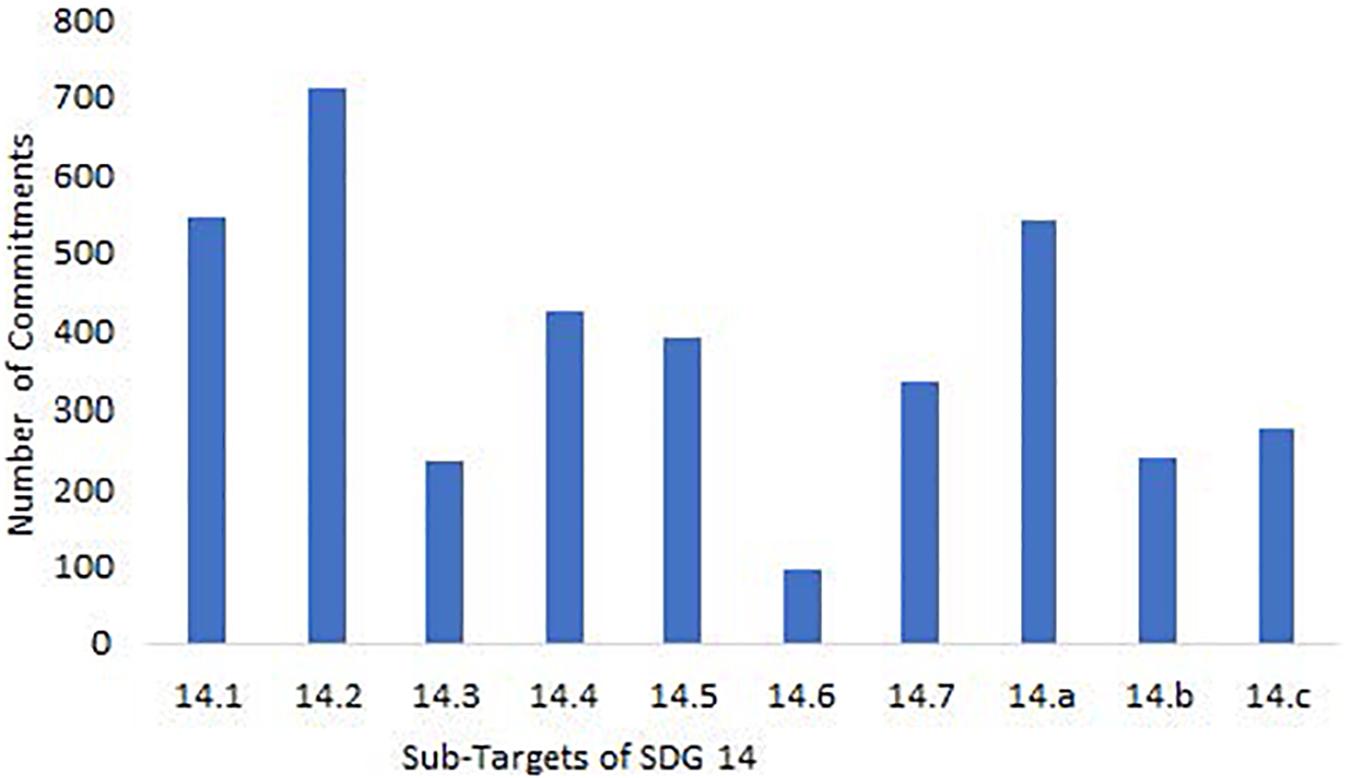
Figure 1. Voluntary ocean commitments. Number of voluntary commitments (N = 3,795) made with regards to sustainable development goal (SDG) 14 (Life under water) subgoal. Note that an individual commitment could address multiple specific goals. Data collected from https://oceanconference.un.org/commitments/ between June 2017 and September 2017.
Who Made the Commitments?
Eleven different types of actors or entities made voluntary commitments to SDG 14, including SDG 14.5. A breakdown of which entities made commitments under SDG 14, and SDG14.5 is shown in Figure 2. Overall, the distribution of the 376 SDG 14.5 implementing commitments across the 11 entities significantly differed from the distribution of the 1395 voluntary commitments across entities (d.f. = 10, p = 0.04). This difference was driven markedly by the under performance of the private sector and academia and the over representation of NGOs and CSOs.
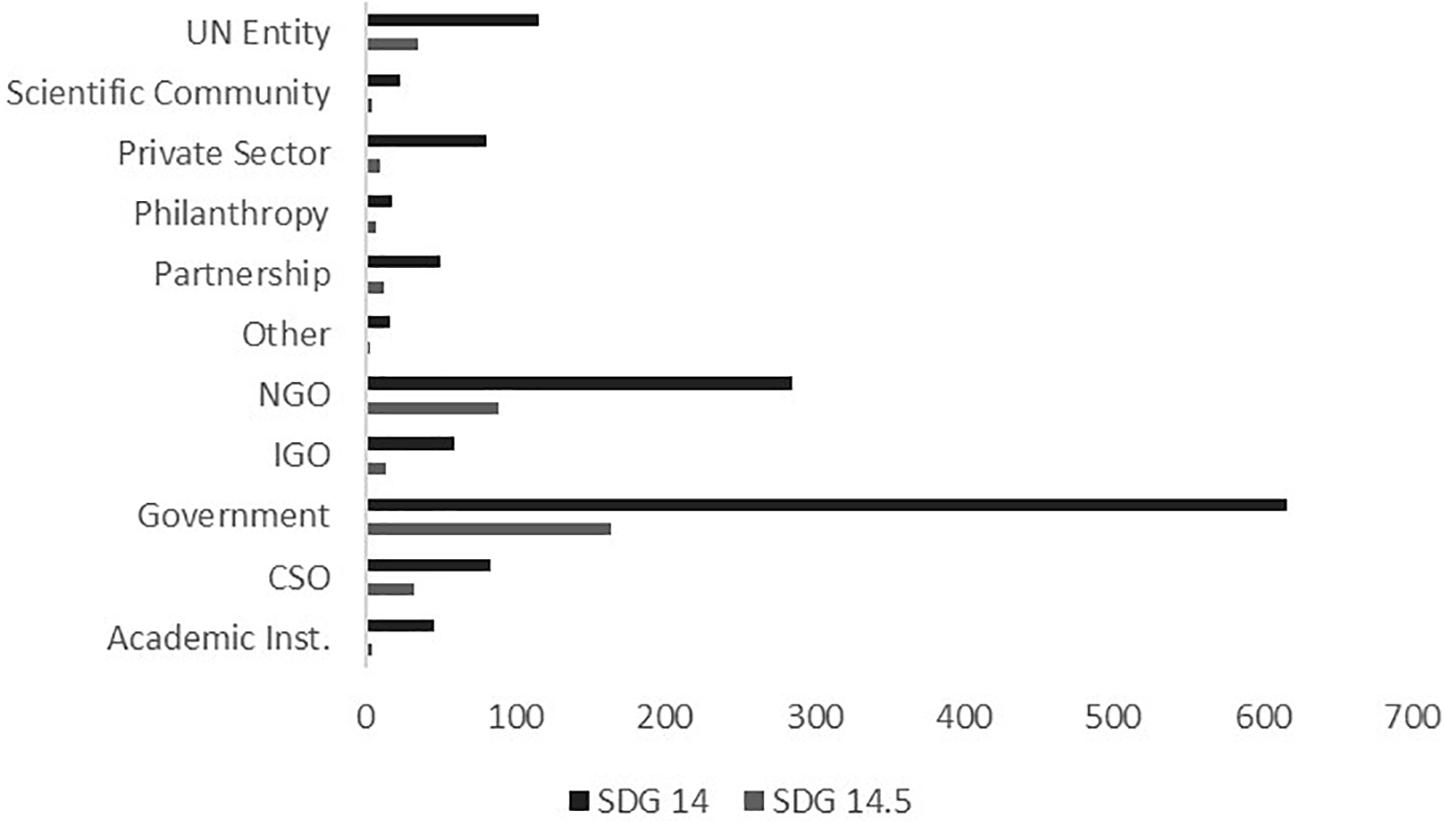
Figure 2. Number of commitments made under SDG 14 and SDG 14.5. Sustainable development goal (SDG) 14 commitments (N = 1,395) and SDG 14.5 commitments (N = 376) sorted by entity who made the commitment. Data collected from https://oceanconference.un.org/commitments/ between June 2017 and September 2017.
What Kinds of MPAs Were Proposed in Voluntary Commitments?
The voluntary commitment portal allowed participants to select preset types of MPA commitments (Figure 3). Twenty-four percent (180 commitments) of the commitments pertain to local and/or community managed MPAs. Multi-use MPAs accounted for 20% (156 commitments) of the commitments. Fifteen percent (144 commitments) of the commitments concern MPAs with partial protection, which can mean the MPA has features such as seasonal closures or fisheries permits. Only 14% (109 commitments) of the commitments were for no-take MPA. Twenty-two percent (171 commitments) of the MPA commitments are toward supporting management and enforcement of MPAs. The category of “Other” allows the entity to put in any deliverable that is not covered by predetermined categories. Other accounted for the lowest percentage, at only 5% (41 commitments) of the total SDG 14.5 commitments.
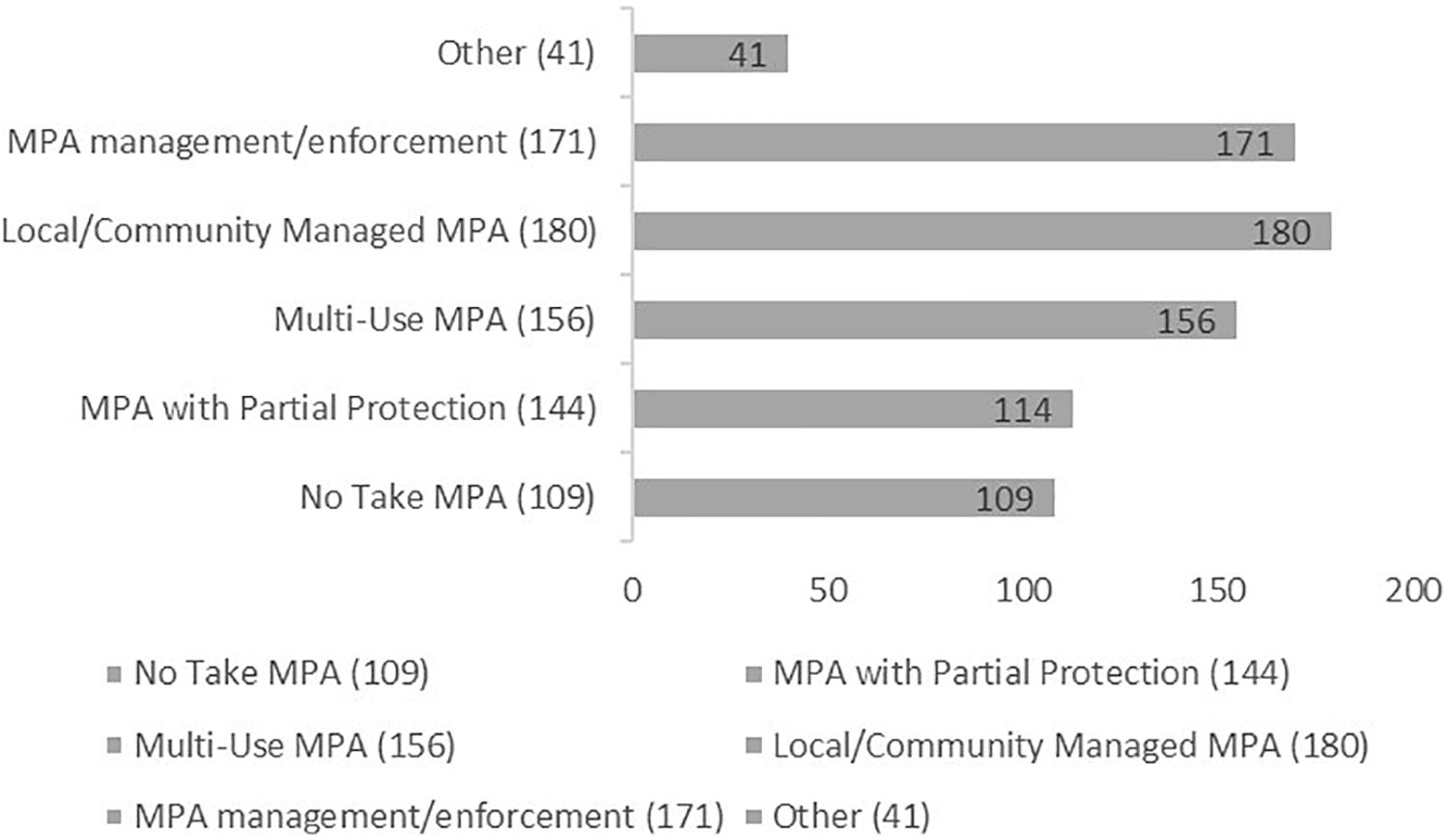
Figure 3. Marine protected area commitments. Voluntary commitments made with regards to sustainable development goal (SDG) 14.5 (marine protected area goal). Chart represents proportion chosen within the different category commitments. Data from https://oceanconference.un.org/commitments/ as of September 2017.
What Kinds of Resilience Are Included?
Resilience was coded 132 times over 91 voluntary commitments for SDG 14.5. Climate resilience accounted for one-third (43 mentions) of the total references of resilience (Table 3), followed by ecosystem resilience at 17% (22 mentions) (Figure 4). Community resilience was accounted for 11% (15 mentions) of the overall references. SES resilience accounted for 8% (11 mentions). Biological resilience accounted for 7.5% (10 mentions), while biological-fish resilience accounts for 5% (7 mentions). General resiliency also made up 5% (7 mentions) of the overall references. Coral resilience accounted for 7% (nine mentions) of the references. Economic resilience accounted for 4% (five times). Coastal resilience only accounted for 2% (three mentions) of the references, although SDG 14 and SDG 14.5 deals with both marine and coastal environments. Lastly, the category of “other” only accounted for >1% (1 mention) of the references.
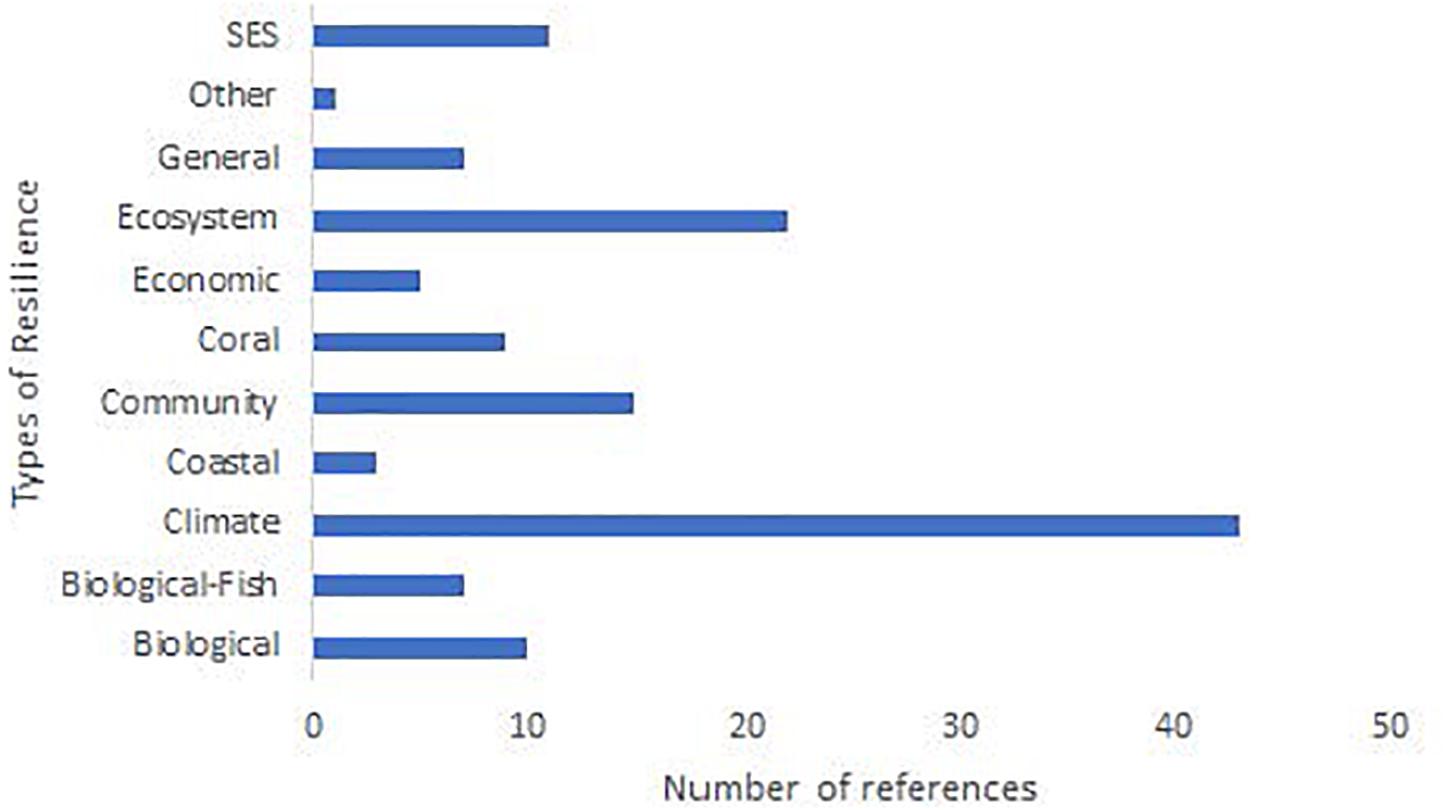
Figure 4. Marine protected area commitments related to resilience. Voluntary commitments made with regards to sustainable development goal 14.5 (related to marine protected areas) which specifically mentions resilience in the descriptor (see Table 2 for definitions of resilience; Table 3 for examples of commitments). Data from https://oceanconference.un.org/commitments/ as of September 2017.
What Actors Use Which Forms of Resilience in MPA Proposals?
Resilience MPA commitments were made by all of the 11 entities that made commitments under SDG 14.5. NGOs made 22% (20 commitments) of the resilience commitments (Figure 5). Consistent with overall trends of entity commitments (Figure 1), government is leading the number of 14.5 commitments that reference resilience at 36% (33 commitments). UN entities accounted for 10% (nine commitments). IGOs accounted for t 9% (nine commitments). The scientific community, private sector, philanthropy, partnership, and CSOs each accounted for 3% (three commitments each). The entity of “Other” made 2% (two commitments) under SDG 14.5 that referenced resilience.
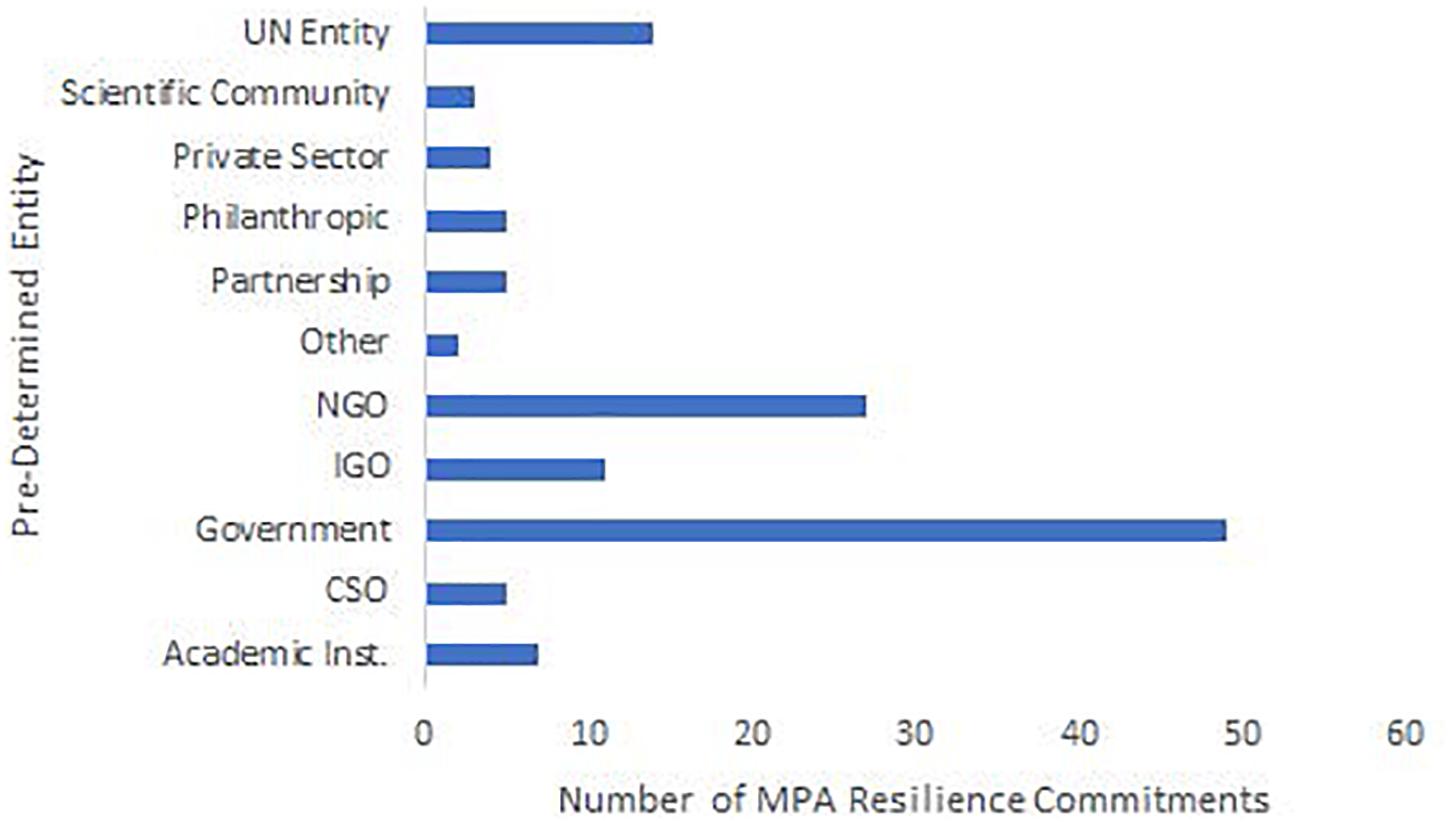
Figure 5. Resilience MPA commitments according to entity. Each commitment description under SDG 14.5 was read for references toward resilience. Data were collected in September 2017. N = 91.
Different entities focused on different types of resilience in their voluntary commitments. Governments made the most references to resiliency overall, accounting for 37% (49) of the overall references. Government’s main focus was on climate resilience over the other forms (Figure 6), accounting for 39% (19 references). NGOs accounted for 20% (27 references) of the overall references. Of these, climate resilience accounted for 22% (6 references) of the NGOs total references to resilience. 100% (three references) of the references of coastal resilience were made by governments.
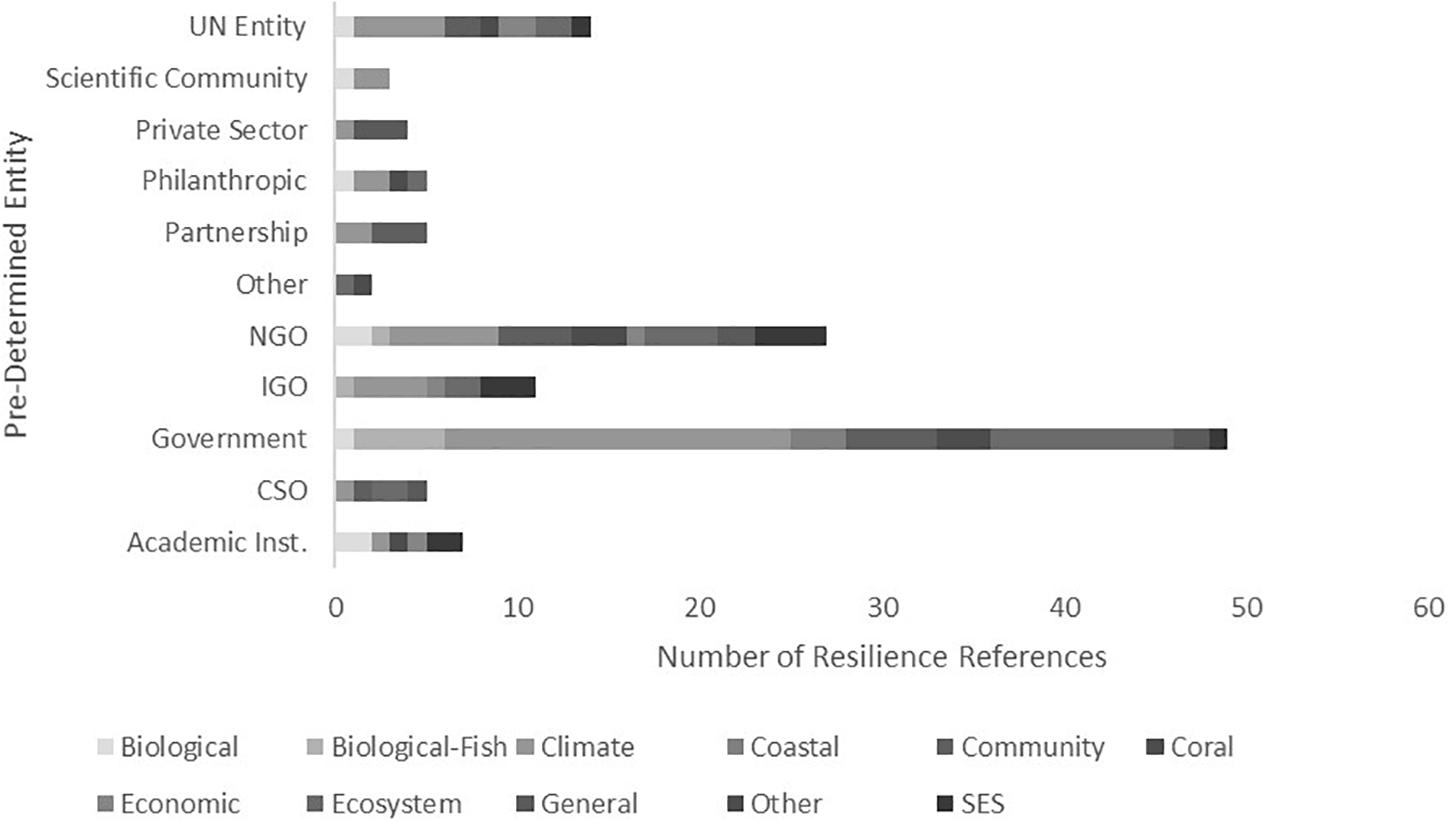
Figure 6. Resilience codes by entity. The panel shows both the number of references made by each entity and the breakdown of what type of resiliency each entity made. See Table 3 for resiliency definitions. N = 132. Data collected from https://oceanconference.un.org/commitments/ as of September 2017.
Looking solely at the governments making resilience MPA commitments (Figure 6), 39% (19 commitments) referred to climate resilience, followed by ecosystem resilience at 21% (10 commitments). Biological–Fisheries resilience accounted for 10% (5), and community resilience accounted for 10% (five commitments). Coral resilience and coastal resilience each accounted for 6% (three commitments) of the government commitments. Only 2% (one commitment) of the commitments were focused on biological resilience, as well as only 2% (one commitment) referred social–ecological system (SES) resilience. No governments made commitments surrounding the economic resilience of MPAs (0 commitments).
Climate resilience dominated the MPA resilience categories (Figure 7). Environmental, which encompasses ecosystem, coral, coastal, biological–fish, and biological forms of resilience accounted for 38% (51 references). Climate, as a single form of resilience, accounts for 32% (43 references) of the references. Social forms of resilience, which include community, economic, and SES, accounted for 23% (31 references). General resilience was singularly grouped, and it only accounted for 5% (seven references), and “other” was singularly coded accounting for >1% (one reference).
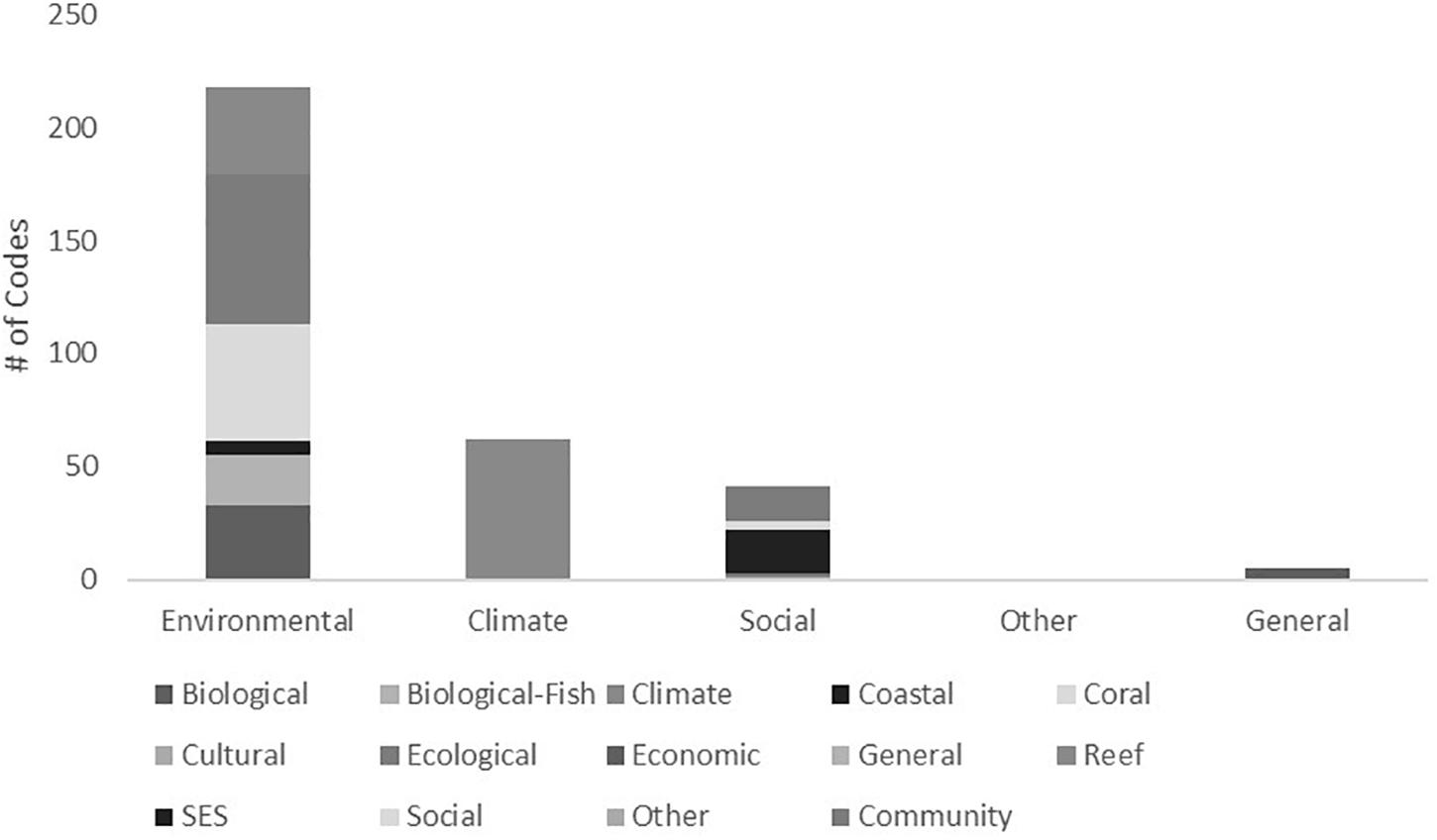
Figure 7. Grouped types of resilience from all entities made in voluntary commitments of SDG 14.5. N = 133. Climate is single coded to emphasize its number and overall importance to entities. Data collected from https://oceanconference.un.org/commitments/ as of September 2017.
What Actors Use Which Forms of Resilience in MPA Proposals?
Overall, there is a significant difference between the distribution of entities making MPA-related commitments under the voluntary commitment process, and those making specific reference to resilience in their commitments (d.f. = 10, p < 0.01). Just as for total MPA commitments, state governments made the greatest number of commitments that incorporated resilience but were actually underrepresented in their use of resilience (n = 49, expected = 57). Similarly, NGOs comprised the second largest number of resilience references, but also underperformed (n = 27, expected = 31). Academic entities were the greatest over performers when it came to resilience references (n = 7, expected = 2). UN entities and IGOs also overperformed in their use of resilience (n = 14, expected = 12 and n = 11, expected = 4, respectively).
Climate resilience was the most dominant form of resilience across all entities. Thirty-nine percent of the resilient MPA commitments made by governments were related to climate resiliency (Figure 6). However, there were no commitments made by governments that related to economic resiliency when discussing SDG 14.5, while NGOs did not focus their use of MPAs on coastal resilience. The scientific community was dominated by a focus on biological and climate resilience (Figure 6).
Where Are the MPA Commitments Being Made?
Multiple nation states made voluntary commitments toward MPAs under SDG 14.5 (Figure 8 and Supplementary Table S1). Sixty-five nation-states governments committed to created MPAs, for a total of 166 potential MPAs. Sweden led the way with 10 voluntary commitments (6%) toward creating MPAs, followed by Canada with 8 voluntary commitments (5%). Pacific Small Island Developing State (PSIDS), as a whole, made 34 voluntary commitments (20%) toward creating MPAs.
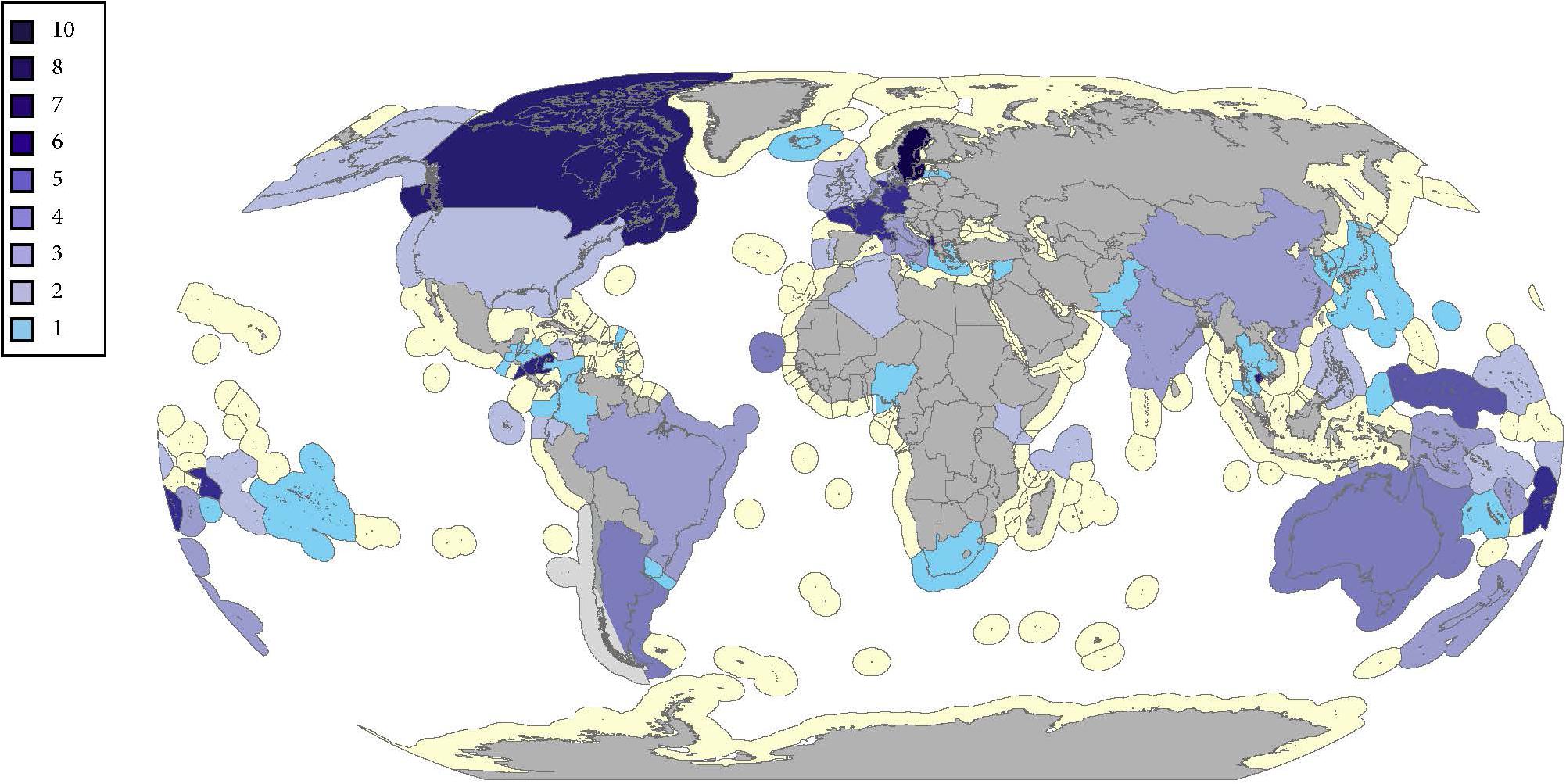
Figure 8. Map of government’s MPA voluntary commitments (SDG 14.5) from 2017 UN Ocean Conference. This map shows proposed areas of new MPAs, within the country’s exclusive economic zone. N = 65 countries, not including the EU. 173 potential MPA sites were identified. Data collected from https://oceanconference.un.org/commitments/ as of November 2018.
Discussion
The UN Ocean Conference brought the marine environment to the forefront of international issues. For the first time, various sectors came together to discuss issues surrounding the oceans, including its conservation and sustainable use of the marine and coastal environment. This is key given international targets and imminent timelines: to conserve 10% of the marine environment by 2020 and to establish a new treaty guiding MPA designation processes on the high seas by 2020. The large number of voluntary commitments made aligns with these global trends (Lubchenco and Grorud-Colvert, 2015; Boonzaier and Pauly, 2016).
Despite much interest by non-state actors (e.g., NGOs, foundations, and the private sector) in taking the mantle of conservation leadership, national governments still made the largest number of commitments. This is consistent with governments being the only entities with the authority to establish and implement MPAs (Agardy, 1994). Thus, the responsibility to fulfill global commitments rests on them. Yet NGOs also made their fair share, showing the commitment of external organizations in working with governments and communities toward developing a global network of MPAs (Christie and White, 2007; White et al., 2010). In our MPA crystal ball, there is a clear indication of the large role of non-state actors in the development of future MPAs, but no indication that establishment and implementation of MPAs will become anything other than a state-led process.
The voluntary commitments toward MPAs ranged from no-take commitments to multi-use and community MPAs. This reflects the complexity inherent in MPAs where trade-offs must be made between conservation and allowing for sustainable use (Hirsch et al., 2010; McShane et al., 2011; Davies et al., 2018). This may also reflect the multiple stakeholders involved in developing MPAs at the national level (Brown et al., 2001). Importantly, having stakeholders, such as the fishing industry, involved in citing MPAs can lead to higher levels of compliance (Oracion et al., 2005) yet it may lead to a less ecologically effective MPA. No-take MPAs, where no use is allowed, have been shown to be the most effective at conserving biodiversity (Lester et al., 2009; Edgar et al., 2014; Costello and Ballantine, 2015; Sala and Giakoumi, 2018). Also, some of the MPA categories, such as multi-use or community, may not even qualify as an MPA. Under internationally recognized IUCN guidelines, community-managed protected areas that are managed mainly for the extraction of marine genetic resources should not be automatically classified as an MPA (Dudley, 2008; Day et al., 2012). In our MPA crystal ball, there is a clear indication that MPAs are no longer just about fisheries conservation.
This research also showed that many entities view the creation of MPAs as a path toward resilience. One of the most highlighted goals of MPAs in recent studies are their role in enhancing resilience (Barnett and Baskett, 2015; Hopkins et al., 2016; Mellin et al., 2016). In particular, the voluntary commitment process involved a heavy focus on MPAs as tools of climate resilience, aligning marine conservation with broader discussions about trajectories for global climate policy. Climate resilience accounted for one-third of the total mentions of resilience, followed by ecosystem resilience at 17% of the mentions (Figure 4). Also, academic entities made the greatest number of references to resilience, which is perhaps to be expected, given the academic origins of the resilience concept. All of the references of coastal resilience were made by governments, which is in line with government priorities of their exclusive economic zones, which are located within 200 nm of a nation-states coastline.
Given that the bulk of the literature deals with ecosystem resilience, there may be a paradigm shift toward climate resilience occurring in terms of practical applications of resilience. This is in line with increasing evidence that MPAs can enhance resilience of marine systems under environmental change and stress (Olds et al., 2014; Mellin et al., 2016; Roberts et al., 2017; Darling and Côté, 2018; Laffoley et al., 2019). The increased focus on resilience in MPAs shows where priorities may lie, such as on resilient fisheries or resilience toward climate change (McClanahan et al., 2012; McLeod et al., 2012; Green et al., 2014; Ford et al., 2016). In our MPA crystal ball, the future aligns marine conservation, ocean conservation, and climate change global priorities, using the lens of climate resilience as a key organizing principle.
Resilience is understood as a key organizing and framing concept that shapes a systems ability to respond to external stresses, and it is a concept widely deployed in adaptation science, ecological science, and common pool resource management theory (e.g., Holling, 1973; Tompkins and Adger, 2004; Mosimane et al., 2012). But what kinds of resilience are being discussed in voluntary commitments? This research revealed the wide array of interpretations of resilience across entities, in line with the lack of clarity around this term in the literature. Nocito (2018) found that the amount of literature surrounding MPAs and resilience has steadily increased since the 1990s, but that only one-third of the papers gave a definition of what form of resilience the authors were referring to within the text. This is concerning when resilience is considered an aim or a goal of a MPA, as without proper definition the success of reaching that aim may come into question.
The voluntary commitments also provided a way to map out potential future MPAs within country’s exclusive economic zones. This mapping exercise shows what countries are – and possibly more importantly are not – pledging future MPAs. While each commitment has its own fulfillment date, this map will help predict where MPAs in exclusive economic zones will exist in the future. The majority of commitments were made in the Pacific, which is expected as the UN Ocean Conference was influenced greatly by PSIDS, as well as co-hosted by the Pacific country of Fiji. The single country making the most MPA commitments was Sweden, totaling in at 10 MPA commitments, followed by Canada at 8 MPA commitments. However, as a region, PSIDS proposed 32 MPAs within the voluntary commitment system. The government of Sweden has committed to fulfilling SDG 14 and Aichi Target 11 through their national legislation body, called the Riksdag (Government of Sweden, 2015). To date, Sweden has 1,373 MPAs in their waters, making them a leader on MPAs in the EU as a whole (see text footnote 1) (European Environment Agency, 2015). The PSIDS, as a unit, are harbor 466 MPAs to date (see text footnote 1). PSIDS have called for a strong commitment to MPAs in international dialogs, and emphasize their commitments previously to creating MPAs (Moses, 2017). In our MPA crystal ball, based on the voluntary commitment process, MPAs are increasingly a tool of wealthy, conservation minded developed countries, and small island states. The lack of commitment from major emerging economies is a sign that work is to be done to build a broader coalition of economic and political leaders for conservation (Miller, 2014).
Ultimately, despite slow progress on achieving global MPA goals, it is clear that the use of area-based management tools as policy instruments to provide protection for oceanic spaces is an idea that is not going away (Boonzaier and Pauly, 2016). Yet the idea of MPAs, like all policy ideas that have come into maturity through implementation, is evolving. It is moving toward the incorporation of a multi-sector, multi-stakeholder approach in MPA development and in the proposal process for MPAs. MPAs are now fully understood to be tools of climate change resilience, yet, ultimately, their success must still be measured by the efficacy of their implementation for achieving an increasingly broad set of policy-goals.
Sustainable development goal 14 is set to expire in 2020. By that time, the goal is to have 10% of the marine and coastal environment conserved through area-based management tools, such as MPAs. To date, only 4.8% of the global ocean is conserved (see text footnote 1). While these predicted MPAs will add to that, there is still a lot of work to be done to reach 10%. These countries need to act quickly to create and establish these proposed MPAs by 2020, for the goal to be met. Countries must also consider that not all MPAs are created equal. No-take MPAs, or marine reserves, are often seen as the strongest MPAs for conservation and restoration of ocean processes (Russ and Alcala, 2004; Lubchenco and Grorud-Colvert, 2015). If the majority of these proposed MPAs are multi-use, or with partial protections, it will still go toward that 10% goal. However, the benefits derived from them may be less than expected since they are still being used and subject to anthropogenic stress (Lester and Halpern, 2008).
Conclusion
With various international goals and targets aimed at reaching 10% of the marine environment conserved through MPAs by the year 2020, it is fitting that so many entities have turned their attention toward fulfillment. The voluntary commitment portal of the UN Ocean Conference allows these entities to receive well-earned attention of their efforts. From these voluntary commitments came a newfound movement toward resiliency, but also showed the dire need of operational definitions to ensure success. The different types of resilience show what types are being prioritized, and by whom. The voluntary commitment portal also allowed a map of potential future MPAs to be created. This map shows which countries are truly committed to fulfilling SDG 14.5, and emphasizes how few countries actually made SDG 14.5 commitments through the voluntary commitment portal.
Data Availability Statement
All datasets generated for this study are included in the article/Supplementary Material.
Author Contributions
EN, AS, and CB designed the research and wrote the manuscript. EN and AS carried out the research and conducted the analyses.
Conflict of Interest
The authors declare that the research was conducted in the absence of any commercial or financial relationships that could be construed as a potential conflict of interest.
Acknowledgments
We would like to thank Anna McGinn and Anama Solofa for assisting in the collaborative event ethnography at UNOC. EN was supported by the School of Marine Sciences at the University of Maine at the time of the research and is now supported by the Environmental Studies Program at the University of Colorado at Boulder. AS was supported by the National Oceanic and Atmospheric Administration, and the School of Marine Sciences at the University of Maine, and is currently supported by Hamilton College. CB was supported by the Pew Charitable Trusts and the Environmental Studies Program at the University of Colorado–Boulder.
Supplementary Material
The Supplementary Material for this article can be found online at: https://www.frontiersin.org/articles/10.3389/fmars.2019.00835/full#supplementary-material
Footnotes
References
Abelson, A., Nelson, P. A., Edgar, G. J., Shashar, N., Reed, D. C., Belmaker, J., et al. (2016). Expanding marine protected areas to include degraded coral reefs. Conserv. Biol. 30, 1182–1191. doi: 10.1111/cobi.12722
Agardy, T. (1994). Advances in marine conservation?: the role of marine protected areas. Trends Ecol. Evol. 7, 267–270. doi: 10.1016/0169-5347(94)90297-6
Ardron, J., Gjerde, K., Pullen, S., and Tilot, V. (2008). Marine spatial planning in the high seas. Mar. Pol. 32, 832–839. doi: 10.1016/j.marpol.2008.03.018
Barnett, L. A. K., and Baskett, M. L. (2015). Marine reserves can enhance ecological resilience. Ecol. Lett. 18, 1301–1310. doi: 10.1111/ele.12524
Baskett, M. L., and Barnett, L. A. K. (2015). The ecological and evolutionary consequences of marine reserves. Ann. Rev. Ecol. Evol. Syst. 46, 49–73. doi: 10.1146/annurev-ecolsys-112414-054424
Boonzaier, L., and Pauly, D. (2016). Marine protection targets: an updated assessment of global progress. Oryx 50, 27–35. doi: 10.1017/S0030605315000848
Brown, K., Adger, W. N., Tompkins, E., Bacon, P., Shim, D., and Young, K. (2001). Trade-off analysis for marine protected area management. Ecol. Econ. 37, 417–434. doi: 10.1371/journal.pone.0118764
Caselle, J. E., Rasssweiler, A., Hamilton, S. L., and Warner, R. R. (2015). Recovery trajectories of kelp forest animals are rapid yet spatially variable across a network of temperate marine protected areas. Sci. Rep. 5:14102. doi: 10.1038/srep14102
Christie, P., and White, A. T. (2007). Best practices for improved governance of coral reef marine protected areas. Coral Reefs 26, 1047–1056. doi: 10.1007/s00338-007-0235-9
Corbin, J., and Strauss, A. (1990). Grounded theory research: procedures, canona and evaluative criteria. Zeitschrift Fur Sociologie 19, 418–427. doi: 10.1007/BF00988593
Costello, M. J., and Ballantine, B. (2015). Biodiversity conservation should focus on no-take marine reserves: 94% of marine protected areas allow fishing. Trends Ecol. Evol. 30, 507–509. doi: 10.1016/j.tree.2015.06.011
Darling, E. S., and Côté, I. M. (2018). Seeking resilience in marine ecosystems. Science 359, 986–987. doi: 10.1126/science.aas9852
Davies, T. E., Epstein, G., Aguilera, S. E., Brooks, C. M., Cox, M., Evans, L. S., et al. (2018). Assessing trade-offs in large marine protected areas. PLoS One 13:e0195760. doi: 10.1371/journal.pone.0195760
Day, J., Dudley, N., Hockings, M., Holmes, G., Laffoley, D., Stolton, S., et al. (2012). Guidelines for Applying the IUCN Protected Area Management Categories to Marine Protected Areas. Gland: IUCN.
Dudley, N. (2008). Guidelines for Protected Area Management Categories, Vol. 3. Gland: IUCN, doi: 10.2305/IUCN.CH.2008.PAPS.2.en
Edgar, G. J., Stuart-Smith, R. D., Willis, T. J., Kininmouth, S., Baker, S. C., Banks, S., et al. (2014). Global conservation outcomes depend on marine protected areas with five key features. Nature 506, 216–220. doi: 10.1038/nature13022
European Environment Agency, (2015). Marine Protected Areas in Europe’s Seas. Copenhagen: European Environment Agency.
Ford, A. K., Bejarano, S., Marshell, A., and Mumby, P. J. (2016). Linking the biology and ecology of key herbivorous unicornfish to fisheries management in the Pacific. Aqua. Conserv. 26, 790–805. doi: 10.1002/aqc.2623
Gaines, S. D., Lester, S. E., Groroud-Colvert, K., Costello, C., and Pollnac, R. (2010). Evolving science of marine reserves: new developments and emerging research frontiers. Proc. Natl. Acad. Sci. U.S.A. 107, 18251–18255. doi: 10.1073/pnas.1002098107
Gjerde, K. M., Dotinga, H., Molenaar, E., Rayfuse, R., and Warner, R. (2008). Regulatory and Governance Gaps in the International Regime for the Conservation and Sustainable Use of Marine Biodiversity in Areas beyond National Jurisdiction. IUCN, Vol. 1. Amsterdam: Elsevier, doi: 10.1038/535465a
Gjerde, K. M., Nordtvedt Reeve, L. L., Harden-Davies, H., Ardron, J., Dolan, R., Durussel, C., et al. (2016). Proctecting Earth’s last conservation frontier: scientific, management and legal priorities for MPAs beyond national jurisdiction. Aqua. Conserv. 26, 45–60. doi: 10.1002/aqc.2646
Glaser, M., Breckwoldt, A., Deswandi, R., Radjawali, I., Baitoningsih, W., and Ferse, S. C. A. (2015). Of exploited reefs and fishers - A holistic view on participatory coastal and marine management in an Indonesian archipelago. Ocean Coast. Manag. 116, 193–213. doi: 10.1016/j.ocecoaman.2015.07.022
Government of Sweden, (2015). Swedish Strategy for Biodiversity and Ecosystem Services. Stockholm: Government of Sweden.
Green, A. L., Fernandes, L., Almany, G., Abesamis, R., McLeod, E., Aliño, P. M., et al. (2014). Designing marine reserves for fisheries management, biodiversity conservation, and climate change adaptation. Coast. Manag. 42, 143–159. doi: 10.1080/08920753.2014.877763
Halpern, B. S., Lester, S. E., and McLeod, K. L. (2010). Placing marine protected areas onto the ecosystem-based management seascape. Proc. Natl. Acad. Sci. U.S.A. 107, 18312–18317. doi: 10.1073/pnas.0908503107
Hirsch, P. D., Adams, W. M., Brosius, J. P., Zia, A., Bariola, N., and Dammert, J. L. (2010). Acknowledging conservation trade-offs and embracing complexity. Conserv. Biol. 25, 259–264. doi: 10.1111/j.1523-1739.2010.01608.x
Holling, C. S. (1973). Resilience and stability of ecological systems. Ann. Rev. Ecol. Syst. 4, 1–23. doi: 10.1146/annurev.es.04.110173.000245
Hopkins, C. R., Bailey, D. M., and Potts, T. (2016). Perceptions of practitioners: managing marine protected areas for climate change resilience. Ocean Coast. Manag. 128, 18–28. doi: 10.1016/j.ocecoaman.2016.04.014
Laffoley, D., Baxter, J. M., Amon, D. J., Currie, D. E. J., Downs, C. A., Hall-Spencer, J. M., et al. (2019). Eight urgent, fundamental and simultaneous steps needed to restore ocean health, and the consequences for humanity and the planet of inaction or delay. Aqua. Conserv. 1–15.
Lester, S. E., and Halpern, B. S. (2008). Biological responses in marine no-take reserves versus partially protected areas. Mar. Ecol. Prog. Ser. 367, 49–56. doi: 10.3354/meps07599
Lester, S. E., Halpern, B. S., Groroud-Colvert, K., Lubchenco, J., Ruttenberg, B. I., Gaines, S. D., et al. (2009). Biological effects within no-take marine reserves: a global synthesis. Mar. Ecol. Prog. Ser. 387, 33–46. doi: 10.3354/meps08029
Lubchenco, J., and Grorud-Colvert, K. (2015). Making waves: the science and politics of ocean protection. Science 350, 382–383. doi: 10.1126/science.aad5443
Magis, K. (2010). Community resilience: an indicator of social sustainability. Soc. Nat. Resour. 23, 401–416. doi: 10.1080/08941920903305674
McCauley, D. J., Pinksy, M. L., Palumbi, S. R., Estes, J. A., Joyce, F. H., and Warner, R. R. (2015). Marine defaunation: animal loss in the global ocean. Science 347:6219. doi: 10.1126/science.1255641
McClanahan, T. R., Donner, S. D., Maynard, J. A., MacNeil, M. A., Graham, N. A. J., Maina, J., et al. (2012). Prioritizing key resilience indicators to support coral reef management in a changing climate. PLoS One 7:e0042884. doi: 10.1371/journal.pone.0042884
McLeod, E., Green, A., Game, E., Anthony, K., Cinner, J., Heron, S. F., et al. (2012). Integrating climate and ocean change vulnerability into conservation planning. Coast. Manag. 40, 651–672. doi: 10.1080/08920753.2012.728123
McShane, T. O., Hirsch, P. D., Trung, T. C., Songorwa, A. N., Kinzig, A., Monteferri, B., et al. (2011). Hard choices: making trade-offs between biodiversity conservation and human well-being. Biol. Conserv. 144, 966–972. doi: 10.1016/j.biocon.2010.04.038
Mellin, C., Aaron Macneil, M., Cheal, A. J., Emslie, M. J., and Julian Caley, M. (2016). Marine protected areas increase resilience among coral reef communities. Ecol. Lett. 19, 629–637. doi: 10.1111/ele.12598
Miller, D. C. (2014). Explaining global patterns of international aid for linked biodiversity conservation and development. World Dev. 59, 341–359. doi: 10.1016/j.worlddev.2014.01.004
Moore, F., Lamond, J., and Appleby, T. (2016). Assessing the significance of the economic impact of Marine conservation zones in the Irish Sea upon the fisheries sector and regional economy in Northern Ireland. Mar. Pol. 74, 136–142. doi: 10.1016/j.marpol.2016.09.025
Moses, M. (2017). “Pacific small island developing states,” in Proceedings of the United Nations Conference to Support Implementation of Sustainable Development Goal 14: Elements for the Call to Action, New York, NY.
Mosimane, A. W., Breen, C., and Nkhata, B. A. (2012). Collective identity and resilience in the management of common pool resources. Int. J. Commons 6, 344–362.
MPAtlas.org, (2018). Available at: http://www.mpatlas.org/ (accessed October 20, 2018).
National Research Council, (2001). Marine Protected Areas: Tools for Sustaining Ocean Ecosystems. Washington, DC: The National Academies Press, doi: 10.17226/9994
Nocito, E. S. (2018). Marine Protected Areas in Areas Beyond National Jurisdiction: Defining “Success” for Conservation & Management. Master’s Thesis, University of Maine, Orono.
Olds, A. D., Pitt, K. A., Maxwell, P. S., Babcock, R. C., Rissik, D., and Connolly, R. M. (2014). Marine reserves help coastal ecosystems cope with extreme weather. Glob. Change Biol. 20, 3050–3058. doi: 10.1111/gcb.12606
Oracion, E. G., Miller, M. L., and Christie, P. (2005). Marine protected areas for whom? Fish. Tour. Solid. Philippine Commun. 48, 393–410. doi: 10.1016/j.ocecoaman.2005.04.013
Roberts, C. M., O’Leary, B. C., McCauley, D. J., Cury, P. M., Duarte, C. M., Lubchenco, J., et al. (2017). Marine reserves can mitigate and promote adaptation to climate change. Proc. Natl. Acad. Sci. 114, 6167–6175. doi: 10.1073/pnas.1701262114
Rogers, L. A., Olsen, E. M., Knutsen, H., and Stenseth, N. C. (2014). Habitat effects on population connectivity in a coastal seascape. Mar. Ecol. Prog. Ser. 511, 153–163. doi: 10.3354/meps10944
Russ, G., and Alcala, A. C. (2004). Marine reserves: long-term protection is required for full recovery of predatory fish populations. Oecologia 138, 622–627. doi: 10.1007/s00442-003-1456-4
Sala, E., and Giakoumi, S. (2018). No-take marine reserves are the most effective protected areas in the ocean. ICES J. Mar. Sci. 75, 1166–1168. doi: 10.1093/icesjms/fsx059
De Santo, E. M. (2018). Implementation challenges of area-based management tools (ABMTs) for biodiversity beyond national jurisdiction (BBNJ). Mar. Pol. 97, 34–43. doi: 10.1016/j.marpol.2018.08.034
Shedrawi, G., Falter, J. L., Friedman, K. J., Lowe, R. J., Pratchett, M. S., Simpson, C. J., et al. (2017). Localised hydrodynamics influence vulnerability of coral communities to environmental disturbances. Coral Reefs 36, 861–872. doi: 10.1007/s00338-017-1576-7
Smith, D., and Jabour, J. (2018). MPAs in ABNJ: lessons from two high seas regimes. ICES J. Mar. Sci. 75, 417–425. doi: 10.1093/icesjms/fsx189
Tompkins, E. L., and Adger, W. N. (2004). Does adaptive management of natural resources enhance resilience to climate change? Ecol. Soc. 9:10.
United Nations, (2017a). Communities of Ocean Action. Available at: https://oceanconference.un.org/ (accessed October 20, 2018).
United Nations, (2017b). Development of an International Legally Binding Instrument Under the United Nations Convention on the Law of the Sea on the Conservation and Sustainable Use of Marine Biological Diversity of Areas Beyond National Jurisdiction (BBNJ) (A/RES/69/292). San Francisco, CA: United Nations, 1–18. (accessed October 20, 2018).
United Nations, (2018). Sustainable Development Goal 14. Available at: https://sustainabledevelopment.un.org/sdg14 (accessed October 20, 2018).
United Nations, (2016). Our Oceans, Our Future. Available at: https://www.un.org/en/conf/ocean/ (accessed October 20, 2018).
Walker, B., Holling, C. S., Carpenter, S. R., and Kinzig, A. (2004). Resilience, adaptability and transformability in social – ecological systems. Ecol. Soc. 9:5. doi: 10.1103/PhysRevLett.95.258101
Wells, S., Ray, G. C., Gjerde, K. M., White, A. T., Muthiga, N., Bezaury Creel, J. E., et al. (2016). Building the future of MPAs – lessons from history. Aqua. Conserv. 26, 101–125. doi: 10.1002/aqc.2680
Keywords: ocean, marine protected area, marine reserves, United Nations, sustainable development goals, resilience, voluntary commitments
Citation: Nocito ES, Brooks CM and Strong AL (2020) Gazing at the Crystal Ball: Predicting the Future of Marine Protected Areas Through Voluntary Commitments. Front. Mar. Sci. 6:835. doi: 10.3389/fmars.2019.00835
Received: 19 March 2019; Accepted: 27 December 2019;
Published: 22 January 2020.
Edited by:
John A. Cigliano, Cedar Crest College, United StatesReviewed by:
Edward Jeremy Hind-Ozan, Department for Environment, Food and Rural Affairs, United KingdomKaren Nadine Scott, University of Canterbury, New Zealand
Copyright © 2020 Nocito, Brooks and Strong. This is an open-access article distributed under the terms of the Creative Commons Attribution License (CC BY). The use, distribution or reproduction in other forums is permitted, provided the original author(s) and the copyright owner(s) are credited and that the original publication in this journal is cited, in accordance with accepted academic practice. No use, distribution or reproduction is permitted which does not comply with these terms.
*Correspondence: Emily S. Nocito, ZW1pbHkubm9jaXRvQGNvbG9yYWRvLmVkdQ==
 Emily S. Nocito
Emily S. Nocito Cassandra M. Brooks
Cassandra M. Brooks Aaron L. Strong
Aaron L. Strong